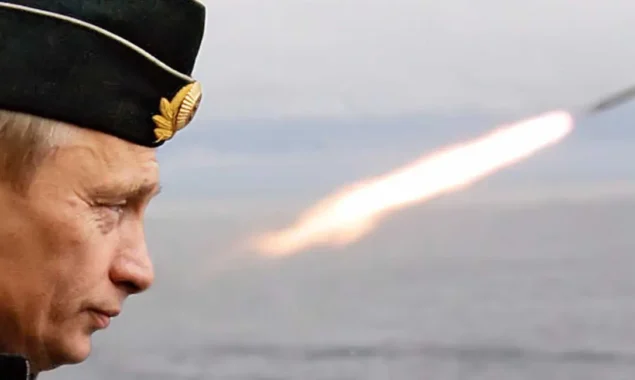
The Cold War was symbolised by nuclear weapons. The current Russian threats in Ukraine’s war have put them back on the radar for many people. What is the mechanism of deterrence, and what type of protection does Europe have?
When Russian President Vladimir Putin placed Russia’s nuclear forces on “special alert” at the outset of the Ukraine war, Europe was taken aback. Putin took the next step in early March, putting nuclear-armed Russian submarines and mobile missile units into military drills. Was he threatening to launch a nuclear attack?
Russia possesses the world’s biggest nuclear arsenal, with around 6,300 warheads. The United States maintains the greatest nuclear force within NATO, with around 5,800 nuclear weapons. France is estimated to have over 300 warheads, whereas the United Kingdom is said to have roughly 215. Exact estimates are not accessible since the countries in issue keep a lot of information about their nuclear projects under wraps.
European protection from nuclear attack
Regardless of the United States’ position as a nuclear umbrella, European countries could not avert a nuclear assault with military means. The “umbrella” is predicated on the notion that an opponent would not dare to deploy nuclear weapons against NATO members because the aggressor would have to expect a retaliation.
Psychology of deterrence
Different conceptions of deterrence are pursued by NATO’s nuclear states. France and the United Kingdom rely on a so-called minimum deterrence. They do not anticipate a series of nuclear strikes over several days; instead, they feel that the capacity to react or halt the opponent with a “last warning shot” (France) will suffice.
The United States, on the other hand, depends on deterrence, which includes nuclear weapons with lower explosive force — US military strategists, at least theoretically, anticipate the prospect of “limited nuclear conflict.”
Legally, practically every use of a nuclear bomb, given the tremendous impact on humans, breaches international humanitarian law. Possible exclusions include a small nuclear assault on a vessel at sea.
German contribution to deterrence
German Air Force Tornado fighter planes stationed at Büchel air base in the state of Rhineland-Palatinate contribute to Europe’s nuclear deterrent. In an emergency, the planes, piloted by Germans, would deliver US nuclear warheads to the target. At least once a year, Bundeswehr pilots practise dropping dummy US nuclear bombs.
The Netherlands, Belgium, and Italy are also members of NATO’s nuclear sharing agreements. According to reports, between 100 and 150 somewhat inaccurate nuclear gravity bombs authorised for Tornado aircraft are now stored in Europe.
“The bombs are a remnant of a bygone period with minimal military importance today,” says Peter Rudolf, a political scientist at Berlin’s German Institute for International and Security Affairs (SWP). To utilise them, however, the enemy’s air defences would have to be destroyed first, which seems unlikely in a large battle.
German Chancellor Olaf Scholz has stated that Germany’s commitment to the nuclear deterrent is not up for debate, despite the fact that the nuclear sharing idea has many detractors within the ruling coalition. Defense Minister Christine Lambrecht revealed on Monday that Germany will replace some of its ageing Tornado bomber planes with nuclear-capable F-35 fighter fighters manufactured in the United States.
Scholz had expressed interest in acquiring the jets shortly after Russia’s invasion of Ukraine.
Who decides on the use of nuclear arms?
The president of the United States is the first to make a decision on the use of US nuclear weapons held in Germany, Italy, Belgium, and the Netherlands. He or she would allow the bombs’ release, and the country where they are stationed would have to agree to the bombs being dropped by its own fighter planes. The other NATO members would probably discuss at the North Atlantic Council (NAC), NATO’s main political decision-making body, prior to such a deployment.
The deployment of the French nuclear force is unilaterally chosen by the French president, whereas the British prime minister takes the choice on behalf of the United Kingdom. The three nuclear decision-making centres are seen as a deterrent because they make it impossible for an adversary to determine how NATO would respond in the case of an attack.
Nuclear weapons in the Ukraine war
The deployment of tactical nuclear weapons on the battlefield is not new in Russian military doctrine. Russia, like the United States, possesses such weapons. Following Russia’s invasion of Ukraine, the media speculated about the possibility of using tactical nuclear bombs over the Black Sea, but Western military experts have found no indication that the Russian military is planning or preparing to deploy tactical or sub-strategic nuclear weapons.
“First and foremost, the Russian threats have a political function,” says SWP expert Rudolf. “It is a message to the US not to interfere in Ukraine beyond a certain limit.”
Nuclear vs. chemical weapons
The Chemical Weapons Convention prohibits the employment of chemical weapons on a global scale. Russia declared the destruction of its last chemical weapon nearly five years ago. The United States intends to meet that target next year. Unlike chemical weapons, which were used even after WWII (most recently in Syria’s civil war), nuclear weapons have not been used since World War II, when atomic bombs were dropped on Hiroshima and Nagasaki in Japan.
“There seems to have been a normative threshold since 1945 to use nuclear weapons in conflicts, despite US deliberations in the 1950s and 1960s,” Rudolf says, adding that policymakers have developed a great reluctance where nuclear arms are concerned.
“This is probably due to feelings of moral discomfort, as well as fear of the consequences,” the SWP expert says, arguing that after all, the use of nuclear weapons “could set off a chain that ends in mutual annihilation.”
Read More News On
Catch all the International News, Breaking News Event and Latest News Updates on The BOL News
Download The BOL News App to get the Daily News Update & Follow us on Google News.




